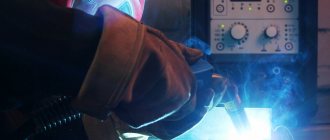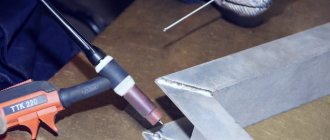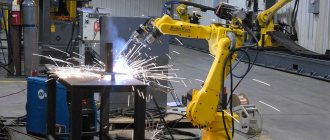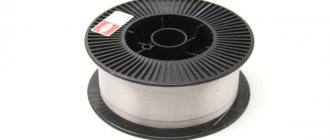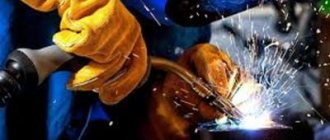Welding allows you to obtain permanent connections that are exceptionally strong. This indicator at the seam must be no lower than the base material, which is achieved by strict technology requirements and the addition of alloying substances. In addition, this process is characterized by connection speed, complexity of the acceptable form, and the ability to control and vary basic parameters. MIG/MAG welding is developing most dynamically in industrial applications, but other types are also being improved. The choice of a specific approach is determined by a number of parameters:
- Material of the parts to be connected.
- Production conditions. MIG, MMA and TIG require different organization and production preparation. The set of necessary equipment can vary from a simple power source to a set that includes a feed mechanism with precise adjustment and a compressed gas cylinder.
- Quality requirements. MIG, MAG, MMA and TIG welding should not always be considered interchangeable - they have different capabilities, including in the formation of the weld.
- Personnel qualifications. The most accessible in this are MAG and MMA. However, RDS is noticeably more difficult with increased requirements and small dimensions: leg, width, height, etc.
- Expected performance. The semi-automatic and automatic process turns out to be much faster than the manual one. Depending on this, suitable types are considered and the optimal one is selected.
MMA
mma technology diagram
In our country, the definition of manual arc welding (and the abbreviation RDS) is common. It is cheaper and easier to organize production and less demanding on equipment.
The connection of two elements in MMA occurs using an electrode - a metal rod coated with a coating containing substances that help maintain the arc, protect the welding zone, and form a seam with the desired properties. When voltage is applied, a stable short circuit is formed between the rod and the workpiece, leading to their mutual melting.
The difficulty may come from requiring welder qualifications. To obtain a neat and reliable joint, skill and long experience are required.
In MMA, special attention is paid to the condition of the electrodes, which should not be wet or crumbling. Do not neglect pre-drying and checking.
Equipment and components
So, for work we need a standard semi-automatic machine. A set of welding equipment consists of a semi-automatic machine, a transformer (generating current), gas (a reducer must be attached to the cylinder to regulate the pressure), various hoses and cables, a gas torch equipped with an additional filler wire supply system and a feed mechanism.
MIG welding is essentially the same as gas shielded consumable electrode welding. Only instead of an electrode, a filler wire is used here. Most often the wire is made of aluminum. We recommend choosing wire made from the same material that you are going to weld.
The wire is wound onto a drum and automatically fed into the welding zone. The feed speed depends on the wire diameter and the current setting you set. All you have to do is point the torch at the welding zone and press the button.
The wire will begin to feed into the welding zone immediately after the arc is ignited. At the same time, the gas will begin to blow over the weld pool, preventing metal oxidation and the formation of defects. Drawing analogies with other types of welding, in our case the gas plays the role of a coated electrode, as in standard MMA welding. Only here the gas is supplied from the outside, and in MMA welding it is formed when the electrode melts.
MIG/MAG
Mig/mag technology diagram
The question of what MIG/MAG welding is should not be misleading, despite the unusual designation.
The English abbreviation MIG/MAG (MIG/MAG) hides the well-known semi-automatic welding with electrode wire in a shielding gas environment.
Instead of a rod, a thin wire acts as an electrode, which is semi-automatically fed into the zone where the weld is formed. This compensates for the melting process and simplifies the performer’s task.
Small diameter wire (from 0.8 to 3.0 mm) allows you to obtain compact connection sizes of a few millimeters.
Fundamentally, MIG differs from MAG in the type of protective gas, which is necessary for isolation from the environment with its high oxygen content in the air. Oxidative processes negatively affect the structure through the formation of intercrystalline rust. MIG welding involves the use of inert gas, which itself does not enter into any chemical reactions, but due to its relatively large weight, tends downward, displacing air. A local microclimate is formed, which shows good results.
MAG welding involves interaction between the natural and created environments, accompanied by the binding of oxygen.
MAG welding
The second type of semi-automatic welding of metals is MAG welding, which is performed in an atmosphere of active gas, for example carbon dioxide. The welding principle itself is identical to the MIG method, but carbon dioxide is pumped into the cylinder, the cost of which is lower than inert gas. The use of this type of welding has slight limitations - only alloy and low-alloy steels can be welded using the MAG method. In terms of ease of operation and breadth of functions, MAG welding is in no way inferior to MIG welding.
Semi-automatic MIG/MAG machines intended for professional use often operate in both modes - both with carbon dioxide and with inert. Such welding equipment allows the welder to regulate the current and can work with wire of any diameter. The most commonly used wire is 0.5-4.0 mm in diameter, but its choice in each individual case depends on the thickness of the metal and its chemical properties.
MAG welding mode in carbon dioxide environment
| Thickness of welded edge, mm | 6.0-8.0 | 4.0-5.0 | 3.0 | 2.0-2.5 | 1.5-2.0 | 1.5 |
| Electrode diameter, mm | 1.2-1.6 | 1.2-1.6 | 1.2-1.4 | 1.0-1.2 | 1.0-1.2 | 0.8-1.0 |
| Current strength, A | 200-300 | 200-300 | 200-300 | 130-170 | 130-150 | 95-125 |
| Active gas consumption, liters/min. | 12-18 | 11-16 | 8-12 | 6-7 | 6-7 | 6-7 |
| Automatic wire feed speed, m/hour | 500-700 | 500-700 | 350-500 | 150-250 | 150-220 | 150-220 |
| Open wire length, mm | 10-20 | 10-20 | 10-13 | 10-13 | 10-13 | 6-10 |
Depending on the model of the semi-automatic machine, welding occurs at idle voltage of 19-30 V. The vast majority of semi-professional and household semi-automatic machines do not have the ability to adjust the supply speed of the working current and voltage. This approach ensures automatic stabilization of the electric arc (auto-correction).
Semiautomatic machines for MIG-MAG welding
All semi-automatic MIG-MAG welding machines on the market today consist of several parts:
- Current generator – inverter or transformer.
- Gas cylinder equipped with a reducer.
- Cables, hoses.
- Torch including wire feed system.
- Wire feeding mechanism.
The role of the electrode that melts is a special wire (aluminum or steel, sometimes it can be other materials), wound on a ram, and fed into the welding zone automatically. The automatic feeding speed of special wire is proportional to its diameter and operating current. The welder moves the torch into the welding zone and presses the handle. When an arc is formed, an electric motor drives a wire of aluminum or steel towards the seam. Meanwhile, the gas under pressure blows over the weld pool and prevents atmospheric gases from reaching the hot metal, which eliminates the process of oxidation of the parts being welded. In this case, the inert gas takes over the functions of coating the electrode used in conventional MMA welding. The main difference here is that the protective atmosphere is not created by burning the electrode coating, but is supplied in ready-made form from the outside.
Advantages of semi-automatic equipment for MIG-MAG welding
Some experts consider semi-automatic MIG/MAG guns to be somewhat cumbersome. Indeed, the package, which includes a gas cylinder, a drum with wire, a transformer or an inverter, does not add mobility to such models. However, semi-automatic MIG-MAG equipment has many advantages compared to other analogues:
- Possibility of welding even very thin metal sheets.
- Minimum consumption of wire made of steel, aluminum or other metals.
- Easy ignition of the arc and its further retention (especially on inverter models).
- No harmful fumes when welding parts.
The relationship between current and wire diameter when welding various metals
Depending on the chemical properties of a particular metal, the required wire diameter and current are selected. The table shows the basic relationships between these two parameters for various materials.
| metal | wire diameter, mm | operating current, and |
| aluminum, aluminum alloys | 0.8 | 50-175 |
| 1.2 | 90-250 | |
| 1.6 | 160-350 | |
| 2.4 | 225-400 | |
| 3.2 | 350-475 | |
| magnesium alloys | 0.8 | 150-300 |
| 1.2 | 160-320 | |
| 1.6 | 210-400 | |
| 2.4 | 320-510 | |
| 3.2 | 400-600 | |
| nickel and its alloys | 0.9 | 100-160 |
| 1.2 | 150-260 | |
| 2.6 | 100-400 | |
| copper, copper alloys | 0.9 | 150-300 |
| 1.2 | 200-400 | |
| 1.6 | 250-450 | |
| 2.4 | 350-550 | |
| stainless steel | 0.8 | 75-150 |
| 0.9 | 100-160 | |
| 1.2 | 140-310 | |
| 1.6 | 280-450 | |
| low carbon steel, rolled, cold drawn | 0.8 | 40-220 |
| 0.9 | 60-280 | |
| 1.2 | 125-380 | |
| 1.3 | 260-460 | |
| 1.6 | 275-450 | |
| carbon steel, some types low alloy steel | 0.9 | 60-280 |
| 1.2 | 125-380 | |
| 1.6 | 275-450 |
Automatic wire feeder in MIG/MAG machines
The convenient functionality of automatic wire feeding in semi-automatic MIG-MAG equipment has a complex mechanism that provides the following advantages:
- Soft smooth start - at the beginning of MIG-MAG welding, the wire comes out at a low speed, allowing the electric arc to ignite and stabilize;
- Eliminating the risk of wire sticking at the very beginning of the operation;
- Smooth adjustment of automatic feed of welding wire and ensuring its constant speed;
- Possibility of changing polarity (in case of using cored wire);
- Protection of the welding wire from welding into the torch after stopping its supply, stopping the current supply before the wire stops;
- Possibility of setting pulse welding mode.
Typically, MIG/MAG welding is carried out with reverse polarity current. However, depending on the task assigned to the specialist and the characteristics of the semi-automatic welding machine, it is possible to use both alternating current and direct polarity.
Operating modes of semi-automatic MIG-MAG
Semi-automatic MIG-MAG equipment has several operating modes:
- Short Arc - welding of thin metals is carried out using pulsating current. In this case, the welding process itself is a series of short circuits, when the molten material of the wire short-circuits the welding voltage.
- Spray Arc – MIG-MAG welding is carried out by pulsating current (spray transfer). The shape of the pulses differs from the Short Arc mode - in this case, the transfer of molten material is carried out in droplet form, which makes it possible to weld metals of relatively large thickness.
- Pulse Arc (pulse-arc) - is a type of Spray Arc mode, but differs from it in the duty cycle of pulses and a lower current value. It is considered the best option for welding non-ferrous metal, aluminum, stainless steel or complex alloys.
- Pulse on Pulse Arc – characterized by pulses with two adjustable current levels (superposition of high and low frequency current pulses occurs). This MIG-MAG welding mode is ideal for decorative welding seams, ensuring not only aesthetics, but also high quality.
Also in MIG/MAG semi-automatic machines there are English-language designations:
- Arc Force – regulation of electric arc energy;
- Lift – high-frequency ignition of the electric arc (usually used in TIG welding);
- Hot start - literally translated as “Hot start” - means an increase in welding current at the beginning of welding work.
Wire for semi-automatic MIG/MAG machines
The principle of welding by the MIG or MAG method is based on a gas atmosphere, which is created using an inert or active gas. However, the quality of the welding wire used also affects the final result. In semi-automatic MIG-MAG equipment, four main types of wire are most often used:
- Aluminum - provides plasticity and high strength of the connection, resistance of the seam to cracking and corrosion. When welding aluminum alloys, where there is a complex chemical composition, experts recommend giving preference to a universal type of welding wire.
- Steel (stainless steel) – the starting material is high-alloy steel. Also, the consumable material contains manganese, nitrogen, phosphorus, carbon, and chromium. This wire is designed for connecting stainless steel elements, while ensuring high corrosion resistance and a reliable seam.
- Copper-plated - has a special coating of copper composition and is suitable for welding carbon and low-carbon steels. The connection is not only neat, but also really strong.
- Powder - inside a hollow metal wire there is a powder that consists of antioxidants: ferroalloys, various ores, complex chemical compounds. The use of powder consumables in MIG-MAG welding allows you to weld various metals without gas, since the burning flux takes over its functions. Compared to the coating of electrodes used in MMA welding, the powder practically does not emit toxic substances into the atmosphere (in the total composition it is only 15-40%). In MAG welding, flux-cored wire provides a soft but stable arc.
The most convenient to use are copper-plated and flux-cored wires - MIG/MAG welding is performed at a fairly good speed without the formation of spatter. These consumables are common not only in households, but also in professional environments.
When choosing wire for MIG-MAG welding, it is necessary to take into account not only the composition of the metals that are supposed to be welded, but also what tips can be used with which consumables.
TIG
Tig technology diagram
The decoding of this abbreviation leads to welding with a non-consumable electrode in an environment of inert gases. The main welding material used is thin, sharpened tungsten rods that are strong enough not to melt at operating temperatures. Wire is used as an additive, but its presence is not a prerequisite.
The argon-based protective environment not only sets the correct casting processes, but also creates a melting zone that is local and deep.
TIG is demanding on the level of the welder and on the equipment. Due to its minimal heating, it is usually used to work with aluminum or thin-sheet stainless steel. The same applies to MIG welding.
Flux
Among the types of arc welding, in addition to MIG MMA TIG, it is also worth mentioning that it proceeds under a layer of flux. What flux is has many variations. All possible materials have in common such qualities as flowability, the ability to influence the formation of a seam at all stages of remelting (including under unfavorable external conditions), and the ability to form a monolithic crust after cooling. The use of flux shows very good results, but complicates the process itself and implies additional costs. MIG, TIG and MAG are more economical and easier to implement.
How does welding happen?
The choice of welding current is approximately determined by the graph:
or be according to Table 1.
MAG welding mode (CO2 environment)
Table 1
Welding is carried out at an open circuit voltage of 19-30 V, depending on the features of the semi-automatic machine. On most household and semi-professional semi-automatic welding machines, the current supply speed and voltage are constant and not adjustable. This is done for the purpose of automatic stabilization of the arc (autocorrection).
For welding different metals, the choice of wire diameter and welding current is of primary importance. The main relationships are shown in Table 2.
table 2
The mechanism for moving the welding wire is highly complex and provides very convenient semi-automatic functionality. The MAG/MIG semi-automatic welding machine is equipped with a feed system that allows:
- perform a soft start - the wire at the beginning of welding comes out at a lower speed and allows you to ignite and stabilize the arc;
- after stopping the feed, protect the wire from welding into the torch by stopping the current supply before the wire stops;
- prevent wire sticking at the beginning of the welding process;
- smooth regulation or ensuring a constant feed rate;
- perform pulse welding mode;
- change polarity (for cored wire).
As a rule, MAG/MIG welding is performed on a current of reverse polarity - on the electrode “+”, on the product “-”, but, depending on the tasks facing the welder and the parameters of the machine, direct polarity and alternating current are also possible.
The device can operate in the following modes:
- Short Arc - used below 200 A for thin metals;
- Spray Arc - current ≥200 A and wire diameter greater than 1 mm;
- Pulse Arc - welding with a large wire diameter and low current, used for non-ferrous metals, stainless steel and aluminum, complex alloys;
- Pulse on Pulse Arc - double pulse with variable current, used for decorative seams.
